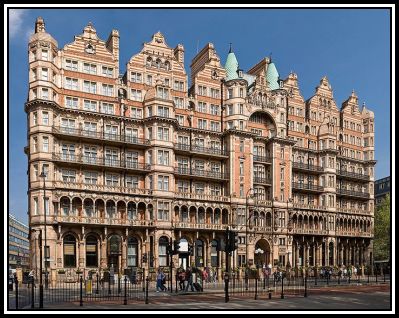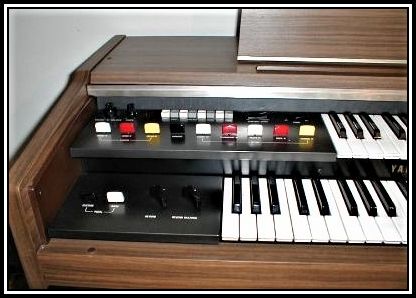LEN RAWLE
THE PROFESSIONAL AMATEUR
& ORGANIST SUPREME
-oOo-
PAGE FIFTEEN:
THE YAMAHA STORY
-oOo-
HAPPENSTANCE …….
-oOo-
Happenstance: a circumstance especially that is due to chance
-oOo-
In 1971, Len was employed as an Employers Liability Surveyor at the Royal Insurance Company. In addition to his family responsibilities, Len enjoyed Music, as a hobby. His hobby included performing at the Theatre Organ along with the restoration and maintenance of a number of these instruments. In addition to these activities, when time permitted, he also enjoyed working on the building of scale-model aircraft with his son, Richard.
Len was in the habit of attending, when possible, the Annual Music Trade Fairs that were held in London. On one such occasion, he attended the Fair being held at the Hotel Russell (renamed as The Principal in 2018) in Russell Square.
 Hotel Russell
Hotel Russell
Photo by DAVID ILIFF. License: CC BY-SA 3.0
Len went along to the Fair in the hope meeting a few other Theatre Organists and enthusiasts. What he noticed was that there were stands displaying the latest instruments from over thirty different Electronic Organ Manufacturers, all of which were crowded with visitors. Apparently, the only stand where established organists were not to be found was the one featuring the all-new Yamaha instruments.
Len wandered over to the Yamaha stand in order to investigate the little Electones with strange-looking volume levers in place of the traditional organ stops.
-oOo-
Hammond pioneered the first Electronic Organ in the 1930s. These were soon followed by models manufactured by a variety of other companies.
Electone is the Trademark used for those Electronic Organs manufactured by The Yamaha Corporation and were first introduced in 1959 with the D-1, an instrument intended for home use. The design of most Electones was based on the Spinet (i.e. a smaller type of Harpsichord or other keyboard instrument, such as a Piano or Organ) Electronic Organ and advertisements were originally aimed at organists who were already competent at the piano. These instruments had simplified controls and functions that were cheaper to produce and less off-putting to learn. An advance featured on many of the Spinets was the Automatic Chord Generation. Here a Chord (i.e. a group of three or more notes sounded together, as a basis of Harmony) is struck to accompany the melody merely by playing the Tonic Note (i.e., a single key), on a special section of the manual.
Today, models are completely Digital and contain a variety of sounds, effects, and accompaniments, on top of the ability to store programming data onto memory devices
-oOo-
 Early Electones
Early Electones
Upper Left: B2 Model; Upper Right: B4 Model; & Lower: B5BR Model
The Electones that Len saw that day at the Fair were models B2, B4 and B5. Len says that there was a certain logic to the numbering system of these electronic organs particularly in the early years. The B2, B4 and B5 models were basic instruments with limited specifications. As the numbers became higher, the number of Organ Stops (pitches) increased. As extra features, such as Reverberation and Manual and Pedal Sustain were developed and introduced to the instruments, the identification of each model was changed slightly. Len recalls that the early models had no rhythm units (for example, auto drums), but later when the Corporation added them, the B4 became the B4R and when the specification of this model was slightly expanded, it became the B4BR.

-oOo-
Click here to open the B-4B Manual
-oOo-
For those readers wishing to consult a Glossary of commonly used Electone terms, please follow the link below:
Click here
-oOo-
Len remembers that those in charge of the Yamaha stand at the Music Fair kindly allowed him to play the then-strange looking Electones. He also recalls being especially interested in the Electone levers that resembled lollipops!
Hammond Organ sounds are produced by varying eight Variable Sliders, known as Drawbars,, that are easily adjusted and allow the production of a pure flute tone. By including a different pitch for each Drawbar, they can be mixed together to produce an amazing number of different sounds. However, the organist needed to be familiar with harmonics should they wish to imitate a particular musical instrument or effect.
When Yamaha decided to enter the organ market, the Corporation went one better by making each of their various Stops (coloured tone levers) variable in volume. Thus one can change the volume of not only the flute tone, but also the string and reed Stops. Len says that he preferred this alternative approach. However, not all professional organists in the UK shared his opinion, as they were mostly used to straight forward ON/OFF switches.
 Detail of the B4 Electone showing the Coloured Tone Levers (i.e. Stops)
Detail of the B4 Electone showing the Coloured Tone Levers (i.e. Stops)
Len adds that he finds it hard to believe now that he was able to present a two-hour demonstration using the smallest Yamaha Organ that has only six Stops. Apparently, this small organ demonstrated great versatility and could be made to sound like a church organ, a jazz organ, a harmonium, a guitar, a bagpipe, chimes, a French accordion, etc etc.
Len says that he had great fun doing such demonstrations on the £250–Yamaha Organ compared to a £2,500–Hammond. Len adds that there was no trickery involved in his demonstrations, just very selective and sensitive use of the limited resources of the Yamaha instrument. And so it was, that in no time at all The Yamaha Corporation was out-selling others with this new style home organ. In addition, Len was able to offer a five-year guarantee on every sale – such was the faith that both he and the Corporation had in the absolute reliable quality of the instrument!
-oOo-
While Len was looking around the Yamaha stand, he was recognised by Mr. Bill Drysdale who was a new representative at Kemble Pianos who was trying to distribute brochures advertising the Electones. At that time, Kemble Pianos was in the process of discussing with The Yamaha Corporation about the possibility of allowing their network of retail piano dealers to be used to market the Electones in the U.K. Mr. Drysdale was keen for Len to play the available instruments and experiment and find out their capabilities.
Apparently, at this time, things were not going too well for Yamaha vis-a-vis interest in their Electones. Only a few dealers in Kemble Pianos network of dealers had had the opportunity to evaluate their products and were apparently unimpressed.
After Len had the chance to evaluate the available Electones, he was able to understand the lack of positive response of the dealers. Len said that the unusual look of the controls and the thin sound produced unless the instrument was handled with a very sensitive musical ear and would certainly not impress dealers. However, Len also recognised several unique features that might prove selling points for the product.
As a result of his evaluation of the Electones, Len was asked if he would like to visit the Kemble Pianos factory and Head Office at Bletchley near Milton Keynes and see more of what the Company was doing. Len was happy to accept the invitation.
—oooOooo—
—oooOooo—
—oooOooo—
